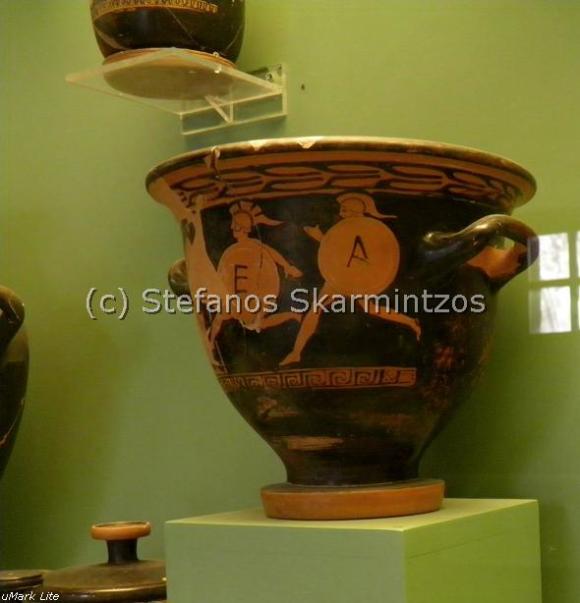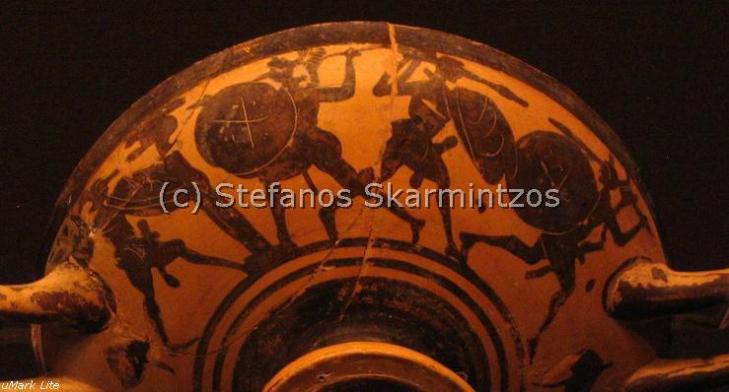The usage of Capital Letters as Shield devices
Most scholars generally agree that the use of the first capital letter from the name of the City State as an emblem on their hoplites shields, started from the fourth century BC.
The main literary source is the «HELLENIKA» of Xenophon where in the fourth chapter of his fourth book mentions in paragraphs from 9 to 12 that the Sikyonians had the capital Greek letter «SIGMA» on their shields and when the Spartans horsemen attacked the Argives after they collected the abandoned shields of some Sikyonian fugitives. The Argives were not worried because they thought they were facing Sikyonians. On this text piece many people support the hypothesis that the Laconic shield device of the time was the «LAMBDA» Laconic shield device of the time was the «LAMBDA» and that its very appearance on the battlefield caused terror.
A second literary source is the «Dictionary» of Photius in which the author quotes the Athenian poet Eupolis who writes that the Messenians use the capital letter «M» on their shields and he is commenting the same for the Spartans when he describes the Letter «Lambda». There is ground for doubting this as all evidences is just a logical guess basse on a medieval source. The «LAMBDA» appears on Hellenistic Spartan coins of king Kleomenes III and again not on its own thus creating further doubt on its usage as a shield device.
Pottery art of the ancient period, however gives indication that the Athenians may have started adopting the capital letter «A» as a shield device quite earlier. The attic vases show the letter «A» arround 421 BC but most images however depict hoplite races and speculated that the shields carried by the hoplites depicted were issued by the State for the needs of the sport and not for war.

Attic red figure pottery from the Rhodes Museum dated between 460 to 425 and depicting a Hoplite race and showing the letters «Α» and «Ε». Probably relating to the Panionian Games at Mt Mycale. The «Ε» can mean Eretrian (?) or Ephesian (?) hoplite.
One image of a hoplite race from the Archaeological Museum of Rhodes allows us to date the usage the capital letters as shield emblems before the middle of the fifth century, however, a black figure cup at the Museum of Cycladic Art in Athens demonstrates the use of this emblem in warfare in the mid sixth century BC. The dating of the capital letter «A» usage probably need to be revised.

Blackfigure pottery from the Museum of Cycladic Art – Athens with a fighting scene. Its dated to the late 6th century BC and it show the earliest representation of the letter «Α»
In some case numismatics give us an indication of a monogram being a city state official emblem as in the case of Phliasia, Phlious, a city state in Pelopononessos located between Corinth, Sikyon and Arcadia. Hero on its coin we have a possible choice for the shield device of this city state’s hoplites emblem

Phliasia, Phlious Æ Chalkous. Circa 400-350 BC. Bull butting to right, head lowered and facing / Large Φ; four pellets around. BCD Peloponnesos 114 (this coin); MacIsaac Issue 1,
If you want to reconstruct Greek hoplites please click here
Thank you Stefanos of you valuable knowledge and taking the time to share this with me. May I please post this information on Promakhoi? Thank you, Gary Thomas
________________________________
Thank you! Please do.
About this:
«The dating of the capital letter “A” usage probably need to be revised.»
You can find this information in «Some Athenian Armour Tokens», John H. Kroll:
«A few Attic vases from the end of the 6th into the second
half of the 5th century depict shields that are
inscribed AOE or simply A, but such shields
are conspicuous by their infrequency. The only
evidence for Athenian shield devices in the
Hellenistic age is that of our tokens, which
might imply that the old custom of personalized
blazons had finally been superseded by the more
militarily sound one of using a uniform state
emblem. But here another factor must be taken
into consideration. As explained below, the
shields represented on the tokens must have
been state property and were naturally inscribed
with a state emblem. It stands to reason, therefore,
that the shields with A or A e E that appear
on a few 6th and 5th century Athenian vases
were copied from shields that in real life were
likewise provided by the state, as opposed to the
privately owned, hence privately decorated,
shields that were regularly carried by Athenian
hoplites during these two centuries».
I will check the “Some Athenian Armour Tokens”, by John H. Kroll
I agree with Mr Kroll on the «AΘE» but I need to see if he has any images.
Also agree with him that the state might provide arms to trained men in times of emergency.
Yet the «E» from Rhodes Museum is on its own and might refer to the Pan-Ionian Games
«The Panionium (Ancient Greek Πανιώνιον, Paniōnion) was an Ionian … was the site of the Ionian religious
festival and games (panegyris) called the Panionia.» (Taken from Wiki)
with the shield being state propert of Ephesos or Eretria for example.
Thank you